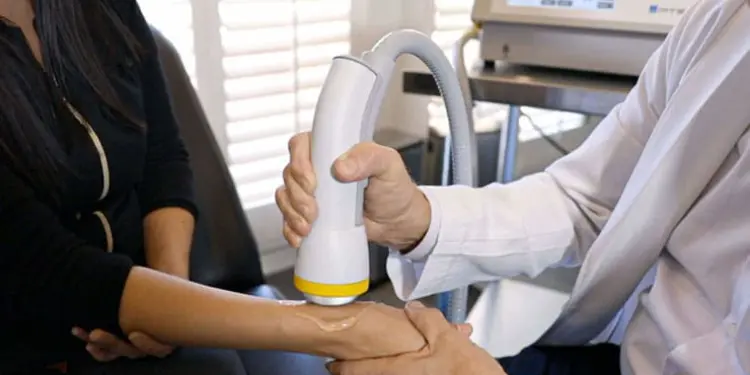Soft wave therapy is gaining traction as a go-to treatment for pain relief and tissue healing, but it’s essential to know the potential Soft Wave Therapy side effects. This article breaks down what soft wave therapy is, common side effects, risks, and tips to make the most of your treatment while minimizing any unwanted effects. Let’s dive into the details so you can feel informed and confident about your choices.
Key Takeaways
- This non-invasive treatment, soft wave therapy, harnesses sound waves to encourage healing in the body.
- Most side effects are mild and short-lived, like temporary redness or discomfort.
- Certain individuals, such as pregnant women and those with pacemakers, should avoid this therapy.
What Is Soft Wave Therapy and How Does It Work?
Soft Wave Therapy is an approach that uses carefully directed sound waves to nudge the body into beginning repair on its own. It’s a non-invasive method where a device sends energy into areas needing help, which kicks off natural cell repair processes and increases blood flow. This treatment offers a non-invasive approach to tissue repair.

The process is pretty straightforward. Here’s how it works:
- A certified professional applies the hand-held device near the target tissue.
- The device sends bundled sound waves into deeper tissue layers, stimulating cells and encouraging rapid recovery.
- The body responds with increased circulation and cell activation, which can speed up healing at the injury site.
For a quick look at some simple metrics often associated with Soft Wave Therapy, check out the table below:
| Feature | Typical Range | Note |
| Treatment Duration | 10-15 Minutes | Sessions are brief |
| Recovery Time | A Few Hours to Days | Mild side effects may be present |
| Area of Application | Localized Tissue | Focus on injured areas |
Soft Wave Therapy taps into the body’s own restoration abilities, bringing a straightforward and safe option to those looking for recovery without the hassle of surgery or strong medications.
This method emphasizes a natural shift toward healing by encouraging the body to work on repair right where it’s needed most.
Common Side Effects of Soft Wave Therapy
Soft Wave Therapy is known for small side effects that are usually brief and manageable. In most cases, the softwave therapy side effects you might notice include mild skin changes and temporary soreness. People sometimes report a bit of redness, light swelling, and even minor bruising after a session. These side effects are part of the body’s natural response and typically fade on their own.
Here are some common side effects of soft wave therapy:
- Slight redness at the site of treatment
- Minor swelling around the treated area
- Brief discomfort or sensitivity
A quick look at what you might expect:
| Side Effect | Duration | Notes |
| Skin Redness | A few hours to days | Generally fades without treatment |
| Swelling | A few hours to days | Mild and self-resolving |
| Bruising or Sensitivity | A few days | Often accompanied by minor discomfort |
Side effects of soft wave therapy are generally mild and self-limiting. Sometimes, any discomfort is short-lived, and many warnings point to softwave treatment side effects as manageable with normal care.
Remember, if you experience discomfort beyond what seems normal, it’s always a good idea to talk with a professional for advice and reassurance.
Potential Risks and Who Should Avoid Soft Wave Therapy
When considering this treatment, it’s important to be aware of the possible issues that might come up. Some patients might experience discomfort or temporary side effects that can be concerning. In most cases, these symptoms are mild, yet it’s wise to keep an eye on them. Several factors can increase Softwave therapy safety concerns, so discussing your health history is key.

Below are a few points to consider:
- Patients who are pregnant should avoid the treatment due to unknown long-term effects.
- Those with pacemakers or other electronic devices may encounter interference problems.
- Those diagnosed with active cancer or undergoing certain treatments might not be ideal candidates.
It’s also smart to keep in mind the general Regenerative Medicine options available for pain relief that might suit your condition better.
A quick reference table helps outline some risk factors:
| Risk Factor | Description |
| Pregnancy | Effects are not fully tested, caution advised |
| Electronic Implants | Potential interference with device functioning |
| Active Cancer | Possibility of exacerbating condition |
Be sure to have a detailed conversation with your healthcare provider. Clear communication about any pre-existing conditions can help tailor the treatment to your individual needs.
On a related note, patients should also be mindful of the general Softwave therapy risks. Checking for the right fit of treatment is just as important as any benefits it might offer. Engage with a provider who will assess your overall health before starting, ensuring the treatment aligns with your specific needs.
How to Minimize Side Effects and Maximize Benefits
After a Soft Wave therapy session, there are several practical ways to help lower any unwanted side effects and enjoy treatment benefits. Here are some straightforward steps:
- Follow your provider’s post-treatment instructions, like resting the treated area or using ice packs when needed.
- Ensure you’re well-hydrated and eating a healthy diet to assist your body’s healing.
- Keep a steady line of communication with your healthcare team to quickly report any changes or discomfort.
If you opt for a personalized treatment plan, these steps can be especially important for managing mild issues after treatment. Sticking to your provider’s specific advice can be the most reliable way to keep side effects to a minimum.
Taking a few extra minutes to care for yourself after a session can make a noticeable difference in your recovery and overall comfort.
Remember, minor discomforts may happen but they usually fade within a few days. By keeping it simple and following these steps, you help ensure that your body stays on track during the healing process.
To get the most out of your treatment while keeping side effects low, it’s important to follow some simple steps. Start by talking to your doctor about your concerns and any medications you are taking. They can help you find the best options for your needs. Also, make sure to stick to the recommended doses and schedules. This way, you can enjoy the benefits without worrying too much about unwanted effects. For more tips and personalized advice, visit our website today!
Final Thoughts on Soft Wave Therapy
In summary, Soft Wave Therapy is a promising, non-invasive treatment for pain management and healing. While most people experience only mild and temporary side effects, it’s still important to be aware of what might happen. Redness, swelling, or a bit of discomfort can occur, but these usually fade quickly. Always engage with your healthcare provider about your specific needs and any questions or concerns.
Make it a point to talk to your healthcare provider about your unique circumstances and any concerns. They can help you decide if this therapy is right for you. Overall, Soft Wave Therapy could be a great choice for many, but knowing the risks is key to making a smart decision.
Frequently Asked Questions
What is Soft Wave Therapy?
Soft Wave Therapy is a soothing treatment that utilizes sound waves to ease pain and promote tissue healing. It’s a non-invasive method, which means it doesn’t require surgery or any cuts.
Are there any side effects from Soft Wave Therapy?
The side effects are generally mild, with most people feeling slight discomfort or noticing redness in the treated area. These usually go away quickly, often within a few days.
Who should not use Soft Wave Therapy?
People who are pregnant, have a pacemaker, or have certain types of cancer should avoid Soft Wave Therapy. It’s important to talk to your doctor about your health history before starting treatment.
If you have any additional questions or would like to see if softwave therapy is right for you, contact Waters Edge medical clinic for a free consultation and evaluation. You can reach us at 727-550-0855.

